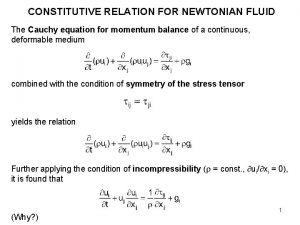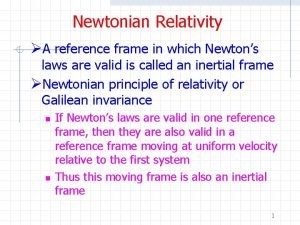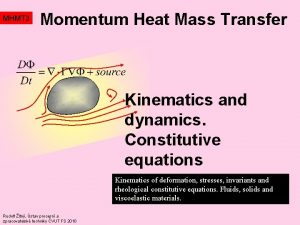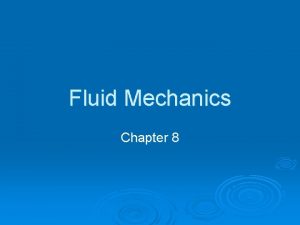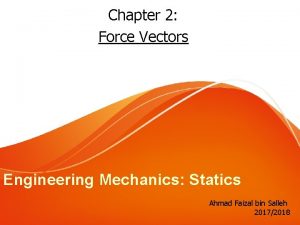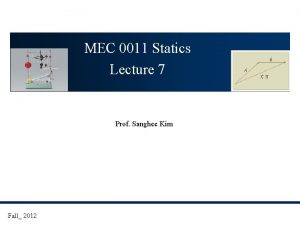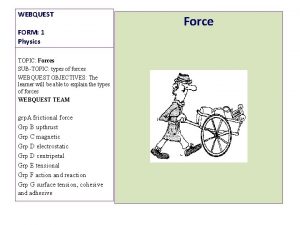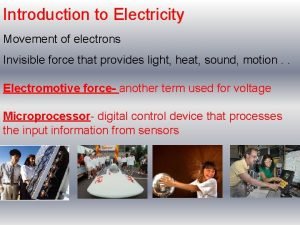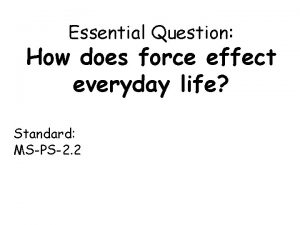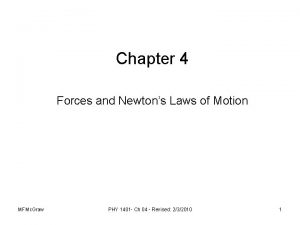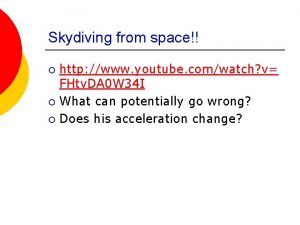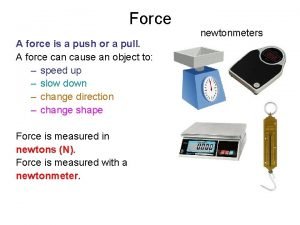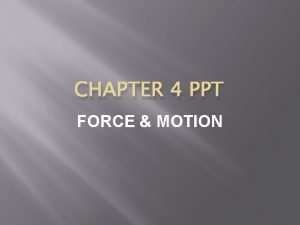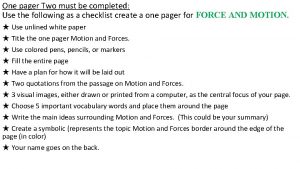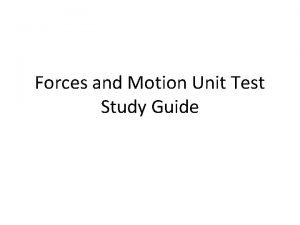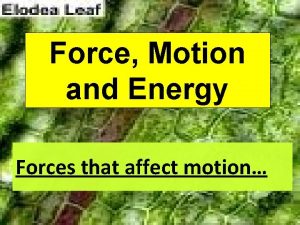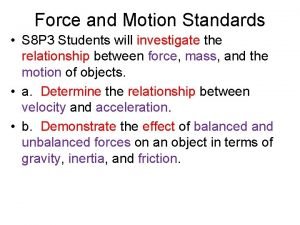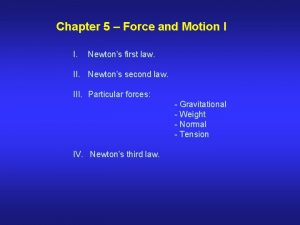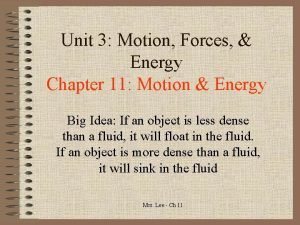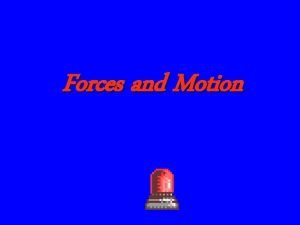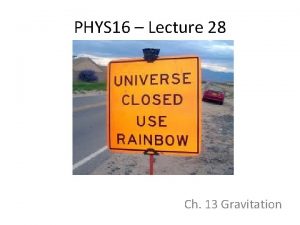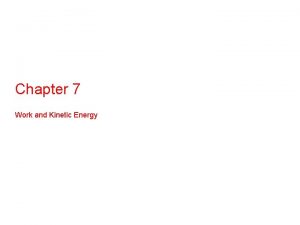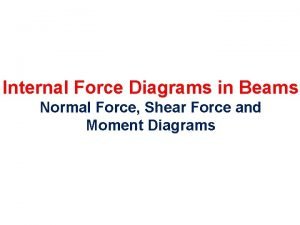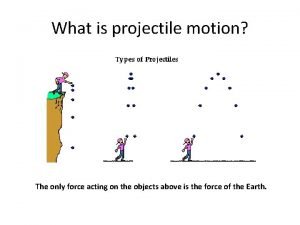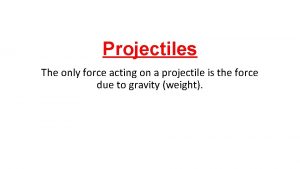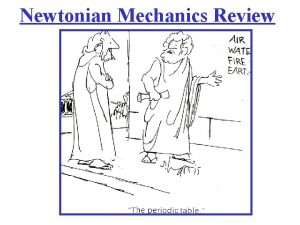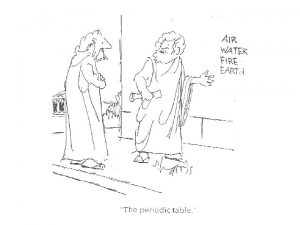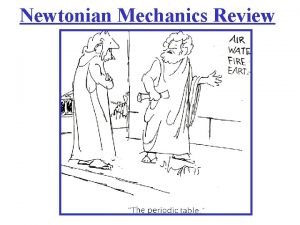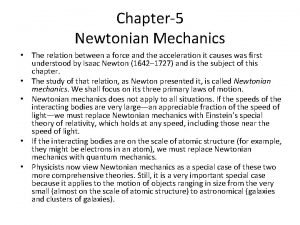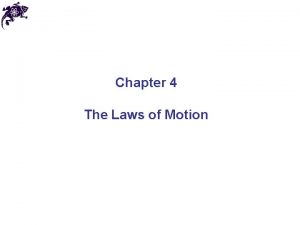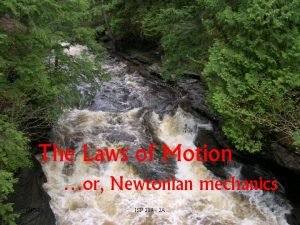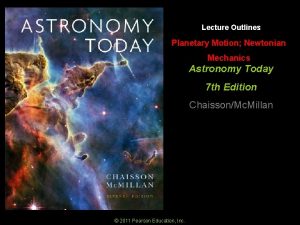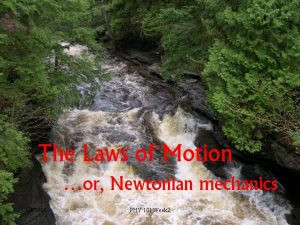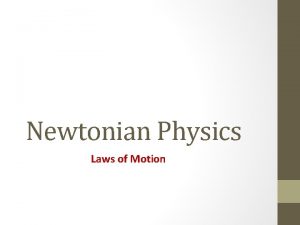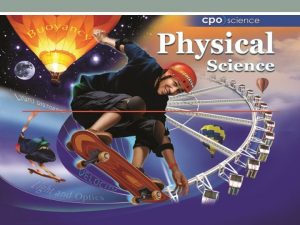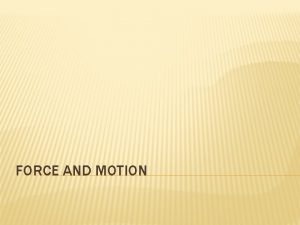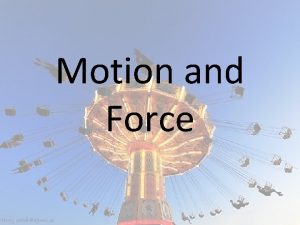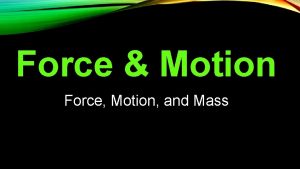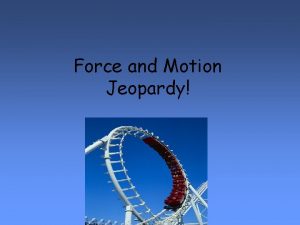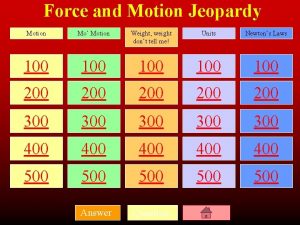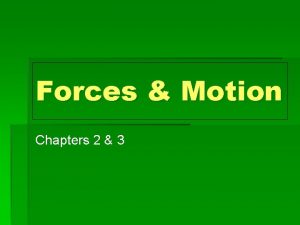Chapters 5 6 Force and Motion Newtonian mechanics











































- Slides: 43

Chapters 5, 6 Force and Motion

Newtonian mechanics Sir Isaac Newton (1643 – 1727) • Describes motion and interaction of objects • Applicable for speeds much slower than the speed of light • Applicable on scales much greater than the atomic scale • Applicable for inertial reference frames – frames that don’t accelerate themselves

Force • What is a force? • Colloquial understanding of a force – a push or a pull • Forces can have different nature • Forces are vectors • Several forces can act on a single object at a time – they will add as vectors

Force superposition • Forces applied to the same object are adding as vectors – superposition • The net force – a vector sum of all the forces applied to the same object

Newton’s First Law • If the net force on the body is zero, the body’s acceleration is zero

Newton’s Second Law • If the net force on the body is not zero, the body’s acceleration is not zero • Acceleration of the body is directly proportional to the net force on the body • The coefficient of proportionality is equal to the mass (the amount of substance) of the object

Newton’s Second Law • SI unit of force kg*m/s 2 = N (Newton) • Newton’s Second Law can be applied to all the components separately • To solve problems with Newton’s Second Law we need to consider a free-body diagram • If the system consists of more than one body, only external forces acting on the system have to be considered • Forces acting between the bodies of the system are internal and are not considered

Chapter 5 Problem 6

Newton’s Third Law • When two bodies interact with each other, they exert forces on each other • The forces that interacting bodies exert on each other, are equal in magnitude and opposite in direction

Forces of different origins • Gravitational force • Normal force • Tension force • Frictional force (friction) • Drag force • Spring force

Gravity force (a bit of Ch. 13) • Any two (or more) massive bodies attract each other • Gravitational force (Newton's law of gravitation) • Gravitational constant G = 6. 67*10 – 11 N*m 2/kg 2 = 6. 67*10 – 11 m 3/(kg*s 2) – universal constant

Gravity force at the surface of the Earth g = 9. 8 m/s 2

Gravity force at the surface of the Earth • The apple is attracted by the Earth • According to the Newton’s Third Law, the Earth should be attracted by the apple with the force of the same magnitude

Weight • Weight (W) of a body is a force that the body exerts on a support as a result of gravity pull from the Earth • Weight at the surface of the Earth: W = mg • While the mass of a body is a constant, the weight may change under different circumstances

Tension force • A weightless cord (string, rope, etc. ) attached to the object can pull the object • The force of the pull is tension ( T ) • The tension is pointing away from the body

Free-body diagrams

Chapter 5 Problem 47

Normal force • When the body presses against the surface (support), the surface deforms and pushes on the body with a normal force (FN) that is perpendicular to the surface • The nature of the normal force – reaction of the molecules and atoms to the deformation of material

Free-body diagrams

Free-body diagrams

Chapter 5 Problem 41

Frictional force • Friction ( f ) - resistance to the sliding attempt • Direction of friction – opposite to the direction of attempted sliding (along the surface) • The origin of friction – bonding between the sliding surfaces (microscopic cold-welding)

Static friction and kinetic friction • Moving an object: static friction vs. kinetic

Friction coefficient • Experiments show that friction is related to the magnitude of the normal force • Coefficient of static friction μs • Coefficient of kinetic friction μk • Values of the friction coefficients depend on the combination of surfaces in contact and their conditions (experimentally determined)

Free-body diagrams

Free-body diagrams

Chapter 6 Problem 23

Drag force • Fluid – a substance that can flow (gases, liquids) • If there is a relative motion between a fluid and a body in this fluid, the body experiences a resistance (drag) • Drag force (D) D = ½CρAv 2 • C - drag coefficient; ρ – fluid density; A – effective cross-sectional area of the body (area of a crosssection taken perpendicular to the velocity); v - speed

Terminal velocity • When objects falls in air, the drag force points upward (resistance to motion) • According to the Newton’s Second Law ma = mg – D = mg – ½CρAv 2 • As v grows, a decreases. At some point acceleration becomes zero, and the speed value riches maximum value – terminal speed ½CρAvt 2 = mg

Terminal velocity Solving ½CρAvt 2 = mg we obtain vt = 300 km/h vt = 10 km/h

Spring force • Spring in the relaxed state • Spring force (restoring force) acts to restore the relaxed state from a deformed state

Hooke’s law • For relatively small deformations Robert Hooke (1635 – 1703) • Spring force is proportional to the deformation and opposite in direction • k – spring constant • Spring force is a variable force • Hooke’s law can be applied not to springs only, but to all elastic materials and objects

Centripetal force • For an object in a uniform circular motion, the centripetal acceleration is • According to the Newton’s Second Law, a force must cause this acceleration – centripetal force • A centripetal force accelerates a body by changing the direction of the body’s velocity without changing the speed

Centripetal force • Centripetal forces may have different origins • Gravitation can be a centripetal force • Tension can be a centripetal force • Etc.

Free-body diagram

Answers to the even-numbered problems Chapter 5: Problem 2. (a)1. 88 N; (b) 0. 684 N; (c) (1. 88 N)ˆi + (0. 684 N)ˆj

Answers to the even-numbered problems Chapter 5: Problem 10. (a)2. 0 N; (b) down

Answers to the even-numbered problems Chapter 5: Problem 22. (a) 5. 5 k. N; (b) 2. 7 s; (c) 4. 0; (d) 2. 0

Answers to the even-numbered problems Chapter 6: Problem 2. 0. 61

Answers to the even-numbered problems Chapter 6: Problem 32. 3. 75

Answers to the even-numbered problems Chapter 6: Problem 36. 48 km/h

Answers to the even-numbered problems Chapter 6: Problem 40. (a) 3. 7 k. N; (b) up; (c) 1. 3 k. N; (d) down

Answers to the even-numbered problems Chapter 6: Problem 104. (a)0. 13 N; (b) 0. 12
 Mv-mu=ft
Mv-mu=ft Newtonian anthropometric data
Newtonian anthropometric data Newtonian
Newtonian Newtonian relativity
Newtonian relativity Newtonian fluid formula
Newtonian fluid formula Modified newtonian dynamics
Modified newtonian dynamics Equation of fluid
Equation of fluid Buoyancy force in fluid mechanics
Buoyancy force in fluid mechanics Simplest equivalent of concurrent force system is
Simplest equivalent of concurrent force system is Statics force vectors
Statics force vectors Force system in mechanics
Force system in mechanics Passive rom vs active rom
Passive rom vs active rom Force and motion webquest
Force and motion webquest Section 3 motion and forces worksheet answers
Section 3 motion and forces worksheet answers Misconceptions about force and motion
Misconceptions about force and motion Is invisible force than can produce heat, light and motion
Is invisible force than can produce heat, light and motion Study jams force and motion
Study jams force and motion Normal force
Normal force Bill nye force and motion youtube
Bill nye force and motion youtube Forces
Forces Force chapter ppt
Force chapter ppt First class lever
First class lever Force and motion unit test
Force and motion unit test Force and motion in plants
Force and motion in plants What is the relationship between force and motion
What is the relationship between force and motion Force and motion ii
Force and motion ii Contact forces
Contact forces Balanced force
Balanced force Jeopardy force and motion
Jeopardy force and motion Mrs lee chapter 11
Mrs lee chapter 11 Force and motion jeopardy
Force and motion jeopardy Newton's laws jeopardy
Newton's laws jeopardy Centripetal force and gravitational force
Centripetal force and gravitational force Normal force and gravitational force
Normal force and gravitational force Draw the shear and moment diagrams
Draw the shear and moment diagrams Shm formula sheet
Shm formula sheet An object in motion stays in motion
An object in motion stays in motion Chapter 2 section 1 describing motion answer key
Chapter 2 section 1 describing motion answer key The main difference between speed and velocity involves
The main difference between speed and velocity involves Section 1 describing motion worksheet answer key
Section 1 describing motion worksheet answer key Describing motion worksheet answer key
Describing motion worksheet answer key Motion section 1 describing motion
Motion section 1 describing motion The only force acting on a projectile is
The only force acting on a projectile is What is the only force acting on the projectile
What is the only force acting on the projectile


